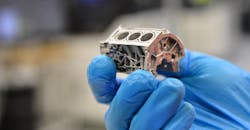Ford, ExOne Seek to Patent High-Speed 3DP for Aluminum
Ford Motor Co. and The ExOne Co. are seeking to patent a 3D-printing process for automotive aluminum alloy 6061 they co-developed, involving a binder-jet process and sintering which they claim, “delivers properties comparable to diecasting.”
Aluminum 6061 contains magnesium and silicon elements, and it feature good mechanical properties and good weldability. It is commonly extruded, forged, and sometimes diecast. Ford and ExOne contend their process for binder-jet printing and sintering aluminum 6061 results in parts with densities greater than 99%.
“This is a breakthrough in making 3D-printed and sintered parts for the auto industry,” stated Harold Sears, Ford technical leader for additive manufacturing. “While the 3D-printing process is very different than stamping body panels, we understand the behavior of aluminum better today, as well as its value in light-weighting vehicles. High-speed aluminum 3D-printing paves the way for other opportunities that we’re just now starting to take a look at because of the ability to do complex parts with aluminum that previously weren’t possible. It’s really opening doors for other opportunities.”
Binder-jet additive manufacturing, also known as “powder bed,” 3D-printing, involves a printer-head selectively depositing a liquid binder onto a layer of powdered materials according to a pattern defined from a CAD file of the finished part. Each completed layer is bonded to a successive layer, according to the design.
Ford has used ExOne binder-jet printers for more than a decade, to produce sand molds and cores for casting metal parts.
When binder-jetting powdered metal, the formed part is later sintered with a combination of heat and atmospheric pressure to densify the part structure. Some aluminum alloys can be 3D-orinted using laser-based selective metal sintering, though the developers claim that but process is much slower than their own.
“The new process is expected to increase Ford’s efficiency by allowing the company to affordably produce complex parts uniquely designed for additive manufacturing, which enables size and weight reductions, part consolidation, and performance improvements,” according to their announcement.
Ford and ExOne initiated their joint development project in 2019. Ford led the final material and repeatability testing to verify its accuracy. A cross-functional team from both partners is working on designs that may use the new material and process.
“Developing a fast, affordable, and easy way to 3D-print aluminum with traditional material properties is a critical step toward light-weighting more products and delivering a more sustainable future,” stated John Hartner, ExOne CEO. “Our world-class engineers and scientists are focused on solving the toughest problems with 3D printing technology, and this achievement is a real win for all of us.”
